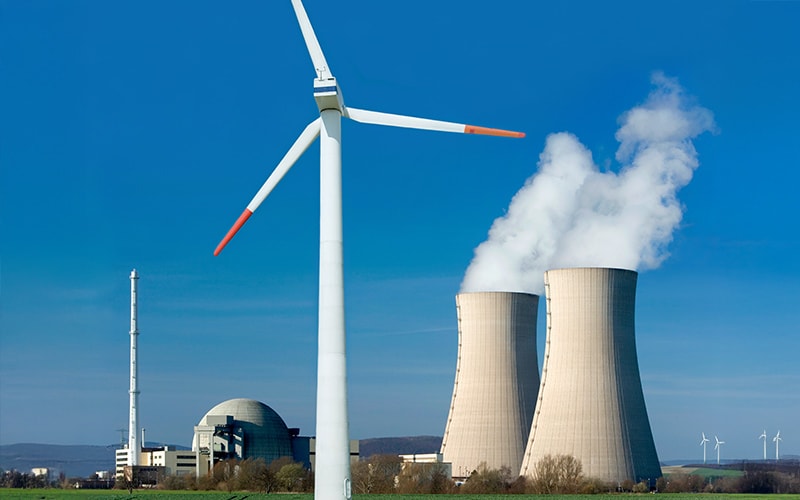Insights
- The energy industry must balance competing forces to meet growing demand and manage the transition to net zero emissions.
- Beyond energy transition, two CEO priorities are the use of generative AI to create an AI-enabled organization and digital transformation.
- Our forecast for generative AI spend by energy, mining, and utilities is growth from $571 million in 2023 to more than $1 billion in 2024 across the energy value chain.
- Industry forecasters estimate new investment in power generation to reach $3 trillion globally in 2024, led by $2 trillion in clean energy, while fossil fuel is expected to decline.
- Not all experts agree with this projection. In its 2023 publication, OPEC expects global demand to reach 116 million barrels per day (bpd) by 2045, up from 100 million bpd in 2022.
- Digitization will continue to improve existing operations for cost competitiveness, safety, reliability, and control of carbon emissions, while driving new revenue opportunities.
Executive summary
The energy industry must balance competing forces as it works to meet growing demand and manage the transition to net zero emissions (Figure 1). Global energy demand is projected to reach 740 million terajoules by 2040, a 77% increase from 2000 levels. In addition, electricity demand is predicted to grow between 3% and 4% a year, potentially more than doubling from 25,000 terawatts today to a range of 52,000 terawatts to 71,000 terawatts by 2050. Industry forecasters gazing through a green lens estimate new investment in power generation to reach $3 trillion globally in 2024, led by $2 trillion in clean energy, while fossil fuel is expected to decline. While the direction may be accurate, market realities will affect the timing and magnitude of this transition. Long lead times for permitting and constructing nuclear and conventional energy plants like hydroelectric facilities are pushing companies toward alternatives such as natural gas-fired plants that can be set up more rapidly, along with green, renewable energy.
The energy mix of tomorrow will differ from what we see today, as sustainable fuels will address sectors difficult to electrify like shipping, aviation, and heavy industries. Energy storage will attract significant investments due to the unpredictability of renewable energy sources. Carbon capture and storage (CCS) will address emissions from fossil fuel-powered plants.
Figure 1. The driving forces behind demand for oil and gas
AI will enhance the efficiency, safety, and reliability of the energy sector.
Beyond energy transition, two CEO priorities are the use of generative AI to create an AI-enabled organization and further adoption of digital technologies to stay competitive and profitable. Our forecast for generative AI spending by energy, mining, and utilities is for it to grow from $571 million in 2023 to more than $1 billion in 2024. Generative AI will be used across the energy value chain, from upstream sources of materials to power generation. AI will be employed to extract value from existing core businesses, pivot toward the creation of new revenue streams, and accelerate the time to market for new offerings.
State of the industry
Fossil fuels provided nearly 80% of the world’s energy demand in 2023 (Figure 2). The International Energy Agency (IEA) has forecast that global demand for oil and gas will peak by 2030. However, not all experts agree with this projection. In its 2023 World Oil Outlook publication, OPEC said it expected global demand to reach 116 million barrels per day (bpd) by 2045, up from approximately 100 million bpd in 2022.
Global disruptions, such as Russia’s war against Ukraine, have pushed the IEA’s peak demand forecast date forward and forced energy leaders to reconsider their strategies. European countries restarted some coal-fired power plants temporarily, extending their planned decommission dates. Meanwhile, countries continue to invest in renewable sources for their own energy security and to reduce their dependence on imported crude oil and natural gas. Combined investments in renewable energy overtook spending on fossil fuels for the first time in 2023. Natural gas and solar energy for electricity generation will reduce the demand for oil by 1.1 million bpd by 2030.
Figure 2. Global energy mix 2023
Short-term outlook
Two current priorities for the energy sector are renewables and energy transition. In the short term, oil production and natural gas as a transition fuel remain a priority, with investments in renewables and electrification of mobility gaining momentum (Figure 3). Additionally, oil production is negatively impacted by geopolitical factors, including Russia’s war against Ukraine, Israel’s war against Hamas, and other Middle East conflicts, as well as by shifts to alternative energy sources.
Figure 3. Top growth areas for the energy industry
Energy transition
The energy sector was responsible for 40% of the CO2 emitted worldwide in 2023, with coal being the biggest contributor. Energy-related carbon emissions grew by 1.1% in 2023, despite significant and growing investments in the renewable sector. To meet net zero targets, this growth must be halted and even reversed. To achieve these goals, countries and energy companies need to reduce their investments in fossil fuel-fired power plants and commit to timelines for shutting down these facilities. However, regulators, utilities, and grid operators must still ensure that power generation stays balanced at all times to match supply with demand, and clean energy on its own has yet to provide a sufficient confidence to do so.
Oil production
OPEC was the largest producer of crude oil in 2023, accounting for more than one-third of the total global output, or 34 million bpd. For 2024, OPEC projected an average daily production of about 30 million bpd among its member countries. However, in the third quarter of 2024, OPEC cut its daily growth forecast from 2.25 million bpd to 2.11 million bpd due to softening demand from China. The organization also lowered its demand growth estimate for 2025 to 1.78 million bpd from 1.85 million bpd.
Global risks and other factors are likely to reduce oil production outlooks — from geopolitical tensions in major oil-producing regions to economic slowdowns in significant consumer markets such as the US and China, to ongoing climate policies aimed at reducing fossil fuel dependence. Some geopolitical risks include the conflict in the Middle East and its escalation, Saudi Arabia and Russia extending or increasing oil production cuts, US shale oil industry inability to meet demand, and poor Chinese economic performance.
Rush to natural gas
Natural gas provides roughly a quarter of the electricity produced globally, trailing coal which produces one-third of the total power output. The market for natural gas power plants is expected to grow 1.5% per year through 2025 due to industrial demand, fast-growing Asian economies, and gas-rich countries in the Middle East and Africa. The annual investment required for natural gas supply and transportation through 2030 is $280 billion, and a side challenge is the need to decrease emissions intensity as well.
Natural gas is efficient to store and transport through pipelines or via ships in a liquefied state. It is also highly effective at producing electricity, up to 60% efficiency in combined cycle power plants. Also, natural gas plants are relatively easy to start and stop to respond to fluctuating demand. However, although natural gas generates significantly less carbon emissions than other fossil fuels, its byproduct methane represents a potent greenhouse gas (GHG).
This flexibility and lower emissions have earned natural gas the reputation as a transition fuel, in contrast to hydrogen, ammonia, biofuels, and others that require additional innovation and scale to become more feasible energy sources. Major oil companies are investing significantly in liquefied natural gas (LNG) plants. A wave of new LNG projects is expected to start operations in mid-2025, with a record increase of 64 million metric tons of annual liquefaction capacity. This trend is powered by companies like Maersk, a leading shipping company that has switched from biofuels to LNG for its fleet modernization and decarbonization efforts. Other shipping companies are expected to follow.
Challenges with natural gas-fired power plants include fuel price variability due to market fluctuations, high initial infrastructure costs for storage and transportation, and methane leaks that can offset its climate benefits over coal.
Electrification of mobility
Electric vehicles (EVs) are becoming more mainstream: global EV energy consumption was less than 1% in 2023 but is expected to reach between 6% and 8% by 2035. Since the transportation sector accounts for 25% of global carbon emissions — and 39% in the US — this shift to electrification is an important pillar in the decarbonization journey, particularly when renewable sources are used to power EVs. One estimate for the reduction in oil demand due to EVs is 6 million bpd by 2030, based on existing policies and trends.
Its flexibility and lower emissions have earned natural gas the reputation as a transition fuel.
Long-term outlook
In the medium to long-term, promising innovations are emerging in many areas: hydrogen and other sustainable fuels, energy storage, CCS, and global supply chain management.
Sustainable fuels
The ongoing imperative to reduce carbon emissions and fossil fuel dependence has accelerated the drive to develop sustainable alternative fuels, with increased viability to back their scientific promise and societal purpose.
Hydrogen. Hydrogen is increasingly recognized as a versatile fuel, energy carrier, and storage solution, particularly for areas hard to electrify like heavy industry and long-haul transportation. The Hydrogen Council estimates that the gas could contribute up to 20% of the world's energy needs by 2050, if significant investments continue to flow into hydrogen infrastructure and technology. However, hydrogen has its own challenges, including high cost and energy-intensive production through electrolysis or natural gas reforming. It has a low energy density, posing challenges in storage, transportation, and safe usage.
Biofuels. Advanced biofuels, derived from algae and waste materials, are becoming more common. These fuels promise lower lifecycle emissions compared to traditional biofuels. Recent innovations focus on improving the efficiency and cost-effectiveness of algae-based fuels. Despite the benefits, biofuels currently face capacity, infrastructure, and supply chain barriers and are highly dependent on government policies and subsidies. Companies are not committing capital to these projects, with large oil and gas companies backing away from their biofuel capital investments. Nevertheless, biofuels are projected to account for 60% of avoided oil demand by 2028.
Ammonia. Ammonia has emerged as a promising fuel, especially for shipping and power generation. It has a high energy density and potential for zero-emission production. Research is ongoing to improve its combustion efficiency and reduce nitrogen oxide emissions. Challenges in developing and adopting this fuel include high production costs, new infrastructure requirements, and technological hurdles.
Hydrogen fuel requires expensive electrolyzers and extensive distribution systems, while biofuels need scalable production methods to compete with traditional fuels economically. Maersk previously committed to biofuel ships but now has changed to LNG and dual fuel ships. The company has delayed the adoption of biofuel ships due to a lack of infrastructure, government subsidies, and supply chain issues in the production and supply of biofuels.
Energy storage
Energy storage solutions, including advanced batteries, are crucial to balance supply and demand on the grid as intermittent renewable sources increase. The development of solid-state batteries and other storage options is gaining momentum, decreasing cost, and increasing reliability. The battery energy storage systems market could reach $120 billion to $150 billion by 2030, more than double its size in 2023, according to one estimate.
Approximately 42 gigawatts of battery storage was added globally in 2023, a year-over-year growth of 130%.
Carbon capture and storage
CCS technologies are being developed and deployed to mitigate carbon emissions from industrial processes and power generation. Recent advancements such as membrane separation, metal-organic frameworks, and new solvents for post-combustion are improving efficiency and reducing the costs to capture and store CO2. The Global CCS Institute is tracking 41 projects in operation and 351 in development globally. Carbon capture capacity has grown at a compounded annual rate of more than 35% between 2017 and 2023.
Supply chain resilience
The energy industry is subject to many risks that threaten supply chains, including the disruption of fuel supplies, volatile commodity prices, increasing environmental regulations, and aging infrastructure. Companies can mitigate some of these challenges through supplier diversification, risk management through digital technologies, optimization and early warnings, and resiliency measures to manage unexpected disruptions.
Supply chain disruptions have significantly impacted the renewables industry due to natural disasters, logistics and installation challenges, factory capacity constraints, raw material shortages, and price fluctuations.
Potential risks to growth
The energy sector faces several strategic risks:
Climate change effects. Extreme weather events and climate change can disrupt energy production and infrastructure, such as hurricanes and floods damaging oil refineries and power plants. In 2017, Hurricane Harvey knocked offline an estimated 20% of the US refining capacity. To mitigate this risk, the sector should invest in resilient infrastructure, incorporate climate risk assessments into planning, and enhance emergency preparedness.
Supply chain disruptions. The energy sector is vulnerable to supply chain disruptions. Effective strategies include diversifying supply sources, incorporating digital systems for transparency, optimization and risk management, investment in local production capabilities, and strategic reserves development.
Regulatory and policy changes. Shifts in government policies and regulations affect the energy sector's operational and financial stability, such as subsidies for fossil fuels or renewable energy that can alter market dynamics. The US government’s methane rule will require natural gas users to implement technologies for measuring and monitoring methane emissions. To navigate these risks, energy companies should engage in policy advocacy, conduct scenario planning, and increase flexibility in their business models.
Technological disruptions. Rapid advancements can make existing technologies obsolete or shift market preferences. For example, innovations in energy storage or generation can reduce the competitiveness of current technologies. Companies can stay ahead by investing in research and development, fostering partnerships with technology innovators, and continuously evaluating emerging technologies. The International Renewable Energy Agency emphasizes the importance of innovation for maintaining a competitive edge.
Cybersecurity threats. As the energy sector increasingly relies on digital systems, it becomes more vulnerable to cyberattacks that can compromise data integrity and disrupt operations. The average number of cyberattacks against utilities each week more than doubled between 2020 and 2022 worldwide, with 1,101 weekly attacks registered in 2022. Robust cybersecurity measures, regular security audits, and industry-wide information sharing are essential to mitigate these threats.
Environmental and social impact concerns. Energy projects can face opposition due to environmental degradation, such as deforestation, or social issues, including community disruption. The Son La hydropower project in Vietnam displaced more than 90,000 people in the mid to late 2000s. The industry can mitigate these risks through transparent stakeholder engagement, rigorous environmental impact assessments, and corporate social responsibility initiatives. The World Bank stresses the importance of incorporating sustainability and social considerations into energy project planning.
Market volatility. Energy price fluctuations affect profitability and investment decisions. Geopolitical instability, supply and demand imbalances, and economic conditions contribute to price volatility. Companies can manage this volatility by employing financial hedging and risk management strategies using risk management platforms, diversifying their energy portfolios, and optimizing operational efficiency.
Emerging trends
The following technologies will play a key role in the future of the energy sector, working in tandem and being well-integrated (Figure 4).
Integrating tailor-made AI
AI will enhance the efficiency and reliability of the energy sector by enabling predictive maintenance, optimizing grid operations, and improving demand forecasting. AI analyzes vast amounts of data and allows companies to improve energy production and distribution. AI, including generative AI, offers value at each stage in the energy value chain (Figure 5). One estimate for the application of AI in the energy sector identified more than 50 use cases and a market size for the technology of up to $13 billion.
Data centers that host generative AI are already major consumers of electricity and sources of carbon emissions. Energy use for running data centers is set to double from 4% of the power produced in the US today to more than 9% by 2030. The energy sector should follow responsible AI practices (security, explainability, fairness, privacy, reliability, IP protection) to control carbon emission from its data centers.
Figure 4. Technologies driving sustainable growth in the energy sector
Cyberattacks on electricity systems are increasing threats to the industry — one with severe consequences. Cyberattacks have grown rapidly since 2018, reaching alarmingly high levels in 2024. Recent cyberattacks have disrupted energy meters due to IT system unavailability, disabled remote control systems for wind turbines, and created data breaches that leaked critical customer information. The average cost of a data breach hit a new record high of $4.9 million in 2024, a 10% increase over the previous year.
Figure 5. The energy value chain and generative AI use cases
Virtual power plants
Virtual power plants (VPPs) have emerged beyond a novel concept to become a leading hope of peak power demand management. These networks of decentralized, distributed energy resources include solar panels, wind turbines, batteries, or electric vehicles. VPPs integrate and collectively manage these resources to function as a single power plant that generates electricity and responds to demand. VPPs manage and control all the power source production and distribution to the smart grid, which maximizes the renewable energy mix, reduces peak demand load, and overcomes the intermittent nature of renewable energy.
The use of energy storage is on the rise, and VPPs are increasingly employed to flatten the fluctuations in power demand and supply. For example, Tesla’s VPP aggregates thousands of batteries used at home to support the local grid on demand.
Energy as a service
In the asset-intensive energy industry — with its high upfront costs — energy as a service (EaaS) can ease the budgetary strain with its subscription-based business model. As customers pay an agreed-upon rate and frequency for each unit of power generated, according to contractual terms and conditions, the cost of operating a power plant becomes an operating expense instead of a capital investment. EaaS is popular for renewable energy, with less complex financial models and lower investment.
Outcome-based pricing is a more advanced version of this EaaS business model, where equipment makers guarantee specific performance outcomes such as equipment uptime and repair time. Not meeting outcomes can lead to a penalty, while outperforming them can result in incentives. GE Vernova sees the outcome as a service business model offering significant promise to the energy industry that needs an internal cultural shift.
EaaS market size was estimated at only $77.5 million in 2023, yet projected to grow from $85.6 million in 2024 to $208.2 million by 2032, at a compound annual growth rate of 11.7%. More than 40% of the market share is expected to be in North America.
Safe, reliable automation
The Electric Power Research Institute considers safety and reliability important parameters for adopting emerging technologies such as AI. Robots are used for handling hazardous materials in power plants, and similarly, mobile robots are used for inspecting radioactive areas in nuclear plants. The operation and maintenance costs for a nuclear plant account for up to 70% of the total cost, with labor accounting for 50% of that total. Mobile inspection robots will help control these costs while adhering to safety requirements. Wildfire detection is a significant application, with cameras always looking for early warnings without the need for human intervention. Research is underway in California in which swarms of drones can quickly identify a fire with chemical sensors, rather than waiting for visual signs of smoke. These drones enable fires to be extinguished before they spread and damage infrastructure such as transmission lines.
Balance of growth and sustainability
In the short to medium term, the energy industry will balance the two important priorities of growth and sustainability. Digital technologies will play a key role to achieve each priority and allow companies to balance these needs while considering the interests of diverse stakeholders. Digitization will continue to improve existing operations for cost competitiveness, safety, reliability, and control of carbon emissions, while driving new revenue opportunities. Organizations that strike the right balance in IT spend to support growth and sustainability — while maintaining legacy operations — will stay competitive and generate the momentum needed to drive industry and society forward.
Organizations that achieve the optimal mix of IT spend to address growth and sustainability will stay competitive.











